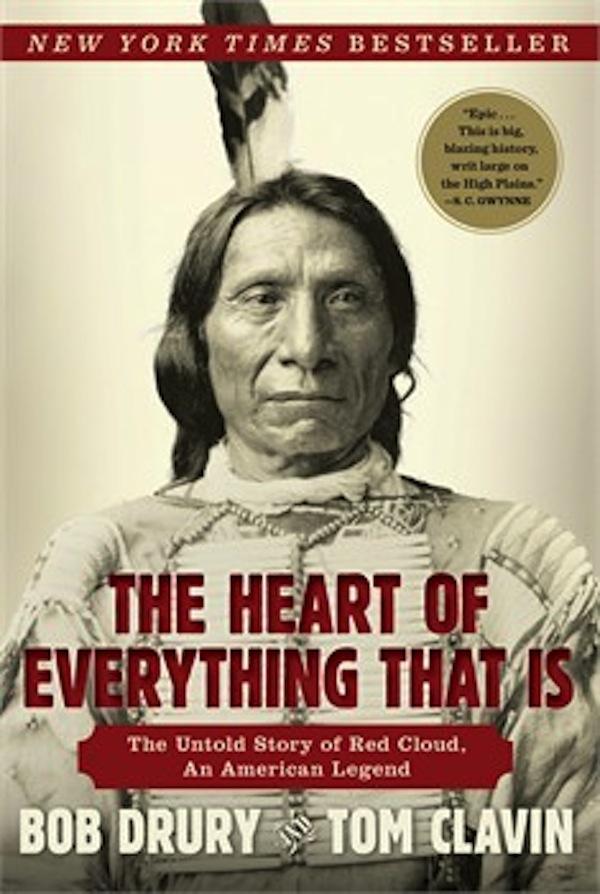Jordan Wright
December 2, 2014
Special to DC Metro Theater Arts
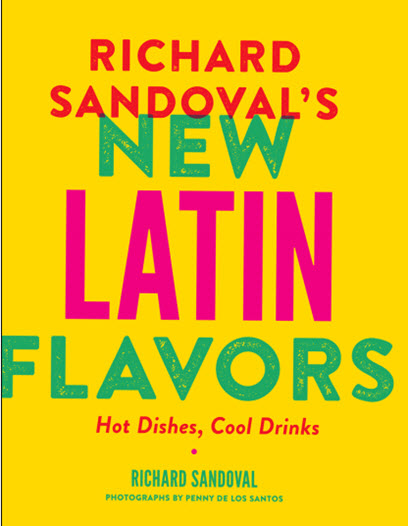
World-renowned chef and international restaurateur Richard Sandoval has penned his latest cookbook, New Latin Flavors – Hot Dishes, Cool Drinks (Stewart, Tabori & Chang) just in time to spice up the holiday season. Most of you will be familiar with his DC Latin/Asian fusion restaurants Zengo, Masa 14, El Centro D. F., but also Ambar with its flavor-forward Balkan dishes, La Sandia in Tyson’s Corner, or the chic, sleek Toro Toro, a churrascaria that opened downtown this April. With thirty-eight successful restaurants worldwide from Dubai to Paris and New York to Mexico, Sandoval’s empire is a testimonial to his delicious contemporary Latin cooking.
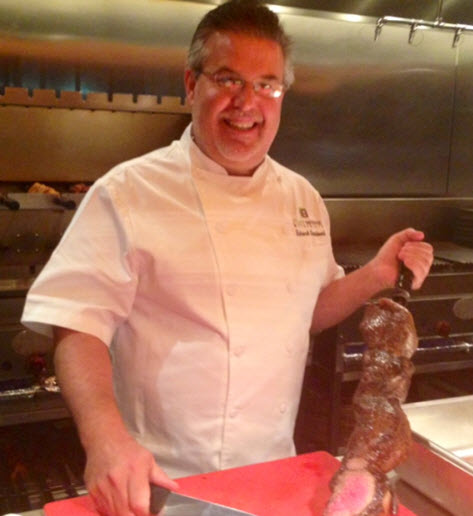 Richard Sandoval serving up churrasco at Toro Toro – Photo credit Jordan Wright In his fifth cookbook Sandoval has given us a collection of 125 inspired recipes that draw from the rich culinary traditions of Mexico, Peru, Venezuela and Argentina. Gorgeous photographs from Saveur photographer Penny De Los Santos grace the pages and highlight the mouth-watering recipes. For the first time Sandoval has tailored a cookbook expressly for the home cook spanning his repertoire of quesadillas, ceviches, arepas and enchiladas plus delicious Latin-inspired cocktails. Think tequila, mescal, cachaça, rum and pisco. Do you feel a party coming on?
Whisk and Quill caught up with Sandoval after he had dodged a blizzard in Denver to get to his DC book launch.
Whisk and Quill – What direction do you think food is going in today?
Sandoval – I think after the recession people’s ways of eating have changed dramatically. The last ten years it went very forward with all these molecular restaurants. I wanted to go retro. You know, back to our roots, back to comfort food and local ingredients, to make people feel comfortable again.
Would you agree that some of the best dishes from the past have been ruined by modernization? Although now I see more chefs returning to the classics but putting their own spin on it.
Absolutely! That’s always been my approach. A lot of my Latin cooking started with my grandmother in her kitchen. I would take dishes, like the mole, and interpret them in my way. I took the roots of these recipes and kept them the way they were meant to be.
What are your favorite ingredients?
I’ve always loved chiles and you’ll always see chiles in my cooking. But as far as cuisines, in the past three or four years I’ve been doing more Peruvian. I love it. And I love Thai food. I’ll be opening a restaurant in mid-January at the new City Center here in DC. It’s called Mango Tree. We brought a chef from Bangkok who worked at one of the other Mango Tree restaurants. I plan to take the roots of their cuisine, tweaking it a little bit as far as my flavor profile and presentation, but leaving the core as it is, maybe just changing the heat level and the balance. I’m incredibly excited. The restaurant already exists in London and Bangkok and Dubai. It’s classic Thai. I’ll just be readjusting it to what I do.
How do you begin to create a fusion dish? Do you start with a single ingredient or do you use your palate’s imagination?
I start with a single dish. The first fusion restaurant I did was Zengo, and Zengo means ‘give and take, back and forth’ in Japanese. It was two chefs, two cultures. First I would do a Latin dish. I hired an Asian chef to work with me and I would give it to him and he would ‘Asianize’ it. Then he would create an Asian dish and give it to me and I would ‘Latinize’ it. It’s two chefs collaborating. It wasn’t just me reinventing Asian, or what I thought it was. This way it made more sense to me.
Why is this book important to you?
When had my first Mexican restaurant twenty years ago, it was doing modern Mexican cuisine – – with more forward thinking. In this book I went retro with more traditional food and more comfort food. It’s very accessible to the home cook. It was very important to me to make sure that when people buy this book, they see it’s about having fun, that it’s not overly complicated where people would look at a recipe and say, ‘Ohmygod, I’ve got to go to Williams Sonoma to get the equipment and will I be able to find the ingredients?’ I wanted to be sure I made it very accessible and very fun.
Who would you most like to dine with living or dead?
I’ve always been very intrigued by Nelson Mandela. How someone can spend so much time in jail and then be able to come out and forgive. Most people would not be able to let go of what happened to them. He just kept moving on with his life and changed his country with his strong spirit and by sharing his ideas.
What if I asked you to name a woman?
Wow! I’ve always liked Shakira! She’s a beautiful woman and a great artist and I love her music.
Maybe she could sing to you.
I don’t think her husband would appreciate that!
We’re fantasizing here.
Okay, I could cook for her and she could sing to me.
Here are a few recipes to spice up any holiday party.
| PONCHE |
Striped Bass Tiradito |
Grilled Tostada with Beef Salpicón |
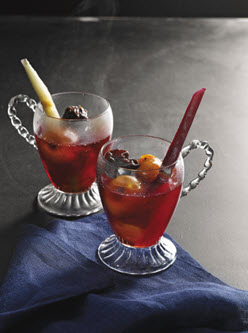 |
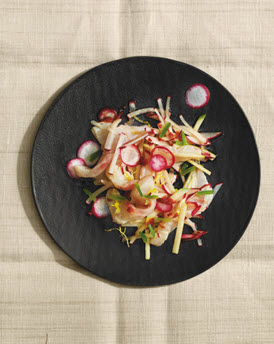 |
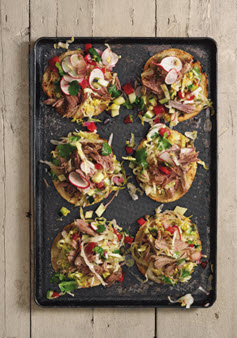 |
- 1/2 cup (2.0 g) dried hibiscus flowers
- (jamaica)
- One 3-inch (7.5-cm) cinnamon stick
- 1 cup (200 g) sugar
- 1/2 cup (130 g) tamarind pulp, broken
- into pieces (see Notes)
- Two 4-inch (10-cm) pieces fresh or
- frozen sugarcane, peeled and cut into
- 12 sticks (see Notes; optional)
- 24 fresh or drained bottled tejocotes
- (see Notes)
- 2 ripe guavas, cut into 12 wedges
- (see Notes)
- One 375-ml bottle (1. cups) 100%
- agave tequila, brandy, or light rum
- 1/4 cup (60 ml) orange-flavored liqueur,
- such as Grand Marnier
- 12 pitted dried plums
The Mexican warm fruit punch of the holiday season, ponche is sometimes nothing more than spiced syrup with booze. My family recipe is better, and infused with the tropical flavors of hibiscus and tamarind.
Serves 10 to 12
[1] Bring 2. quarts (2.5 L) water to a boil in a large nonreactive saucepan over high heat. Remove it from the heat and add the hibiscus flowers and cinnamon stick. Let them stand for 5 minutes. Add the sugar and tamarind and bring them to a simmer over high heat. Reduce the heat to medium-low and simmer, stirring often to break up the tamarind, for 5 minutes. Strain the liquid into a large heatproof bowl, pressing hard on the solids; discard the solids.
[2] Return the liquid to the pot. Add the sugarcane, if using, and bring the liquid to a boil over high heat, stirring to dissolve the sugar. Reduce the heat to medium and cook the liquid at a brisk simmer for 5 minutes. Strain it again to remove any tamarind debris.
[3] Return the tea to the pot and add the tejocotes and guavas. Simmer until the guavas are tender, about 5 minutes. Stir in the tequila and liqueur and simmer just until the mixture is hot. Remove it from the heat, add the plums, and let them stand for 5 minutes. (Do not add them earlier or they will get too soft.)
[4] To serve, return the pot to very low heat to keep the ponche warm. Ladle the ponche into mugs, adding the fruits to each serving. Serve it hot. Notes You can substitute 1⁄3 cup (75 ml) tamarind concentrate for the tamarind pulp. If neither is available, use . cup (120 ml) fresh lemon juice. Fresh or frozen sugarcane is available at Latin groceries and large supermarkets, and is often sold peeled. If the thick skin needs to be removed, use a large knife to chop the cane into manageable 4-inch (10-cm) lengths. Stand the pieces on end to cut away the peel. Cut the sugarcane lengthwise into thick sticks. Tejocote is a small round stone fruit (that is, with a large seed in the center). It is sold fresh at Mexican groceries around Christmas time, and in jars year-round.Kumquats or crabapples are good substitutes because they are similar in size to tejocotes. You may want to alert your guests that the tejocote seeds can be spit out. Pineapple guava, about the size of a large lime, is the most widely available variety around Christmastime. If it is not available, substitute about one-quarter of a pineapple, peeled, cored, and cut into bite-size pieces. Goya, the leading Latin food product manufacturer, sells a nonalcoholic ponche in a jar with enough tejocotes, sugarcane sticks, and guavas for this recipe. Drain and discard the liquid—you really just want the fruit. Leave the tejocotes intact, but cut the sticks and guavas as needed to yield twelve pieces of each. |
with Ponzu, App le & Radish Tiradito de lubina rayada con salsa ponzu, manzana y rábano
- 1/2 Granny Smith apple, peeled
- 2 large radishes, trimmed
- 14 ounces (400 g) skinless striped
- bass, cut on a diagonal into .-inch
- (6-mm) slices
- 1Ž2 cup (120 ml) Ponzu, homemade
- (page 48) or store-bought, chilled
- Finely grated zest of 1 large lemon
- Sriracha, for serving
Tiradito is the South American version of ceviche, and it often has Asian influences, such as the ponzu in this recipe. It is one of the lightest (and quickest) first courses you’ll ever make, yet at the same time, it is one of the most flavorful. There are many good brands for sale, but it is also easy to make your own (page 48), and it is worth the minimal effort for this recipe, where it plays such a big role.
Serves 4
[1] Just before serving, use a V-slicer or mandoline to cut the apple and radishes into julienne. (You can also use a chef’s knife.) Combine them in a small bowl.
[2] For each serving, fan the bass on a chilled
serving plate with a rim. Spoon 2 tablespoons of the ponzu around, but not on, the bass.Top each with one-quarter of the apple mixture and the grated lemon zest. Serve immediately, with the Sriracha on the side. |
tostada con salpicón de res
For the Salpicón Dressing:
- 1/4 cup (60 ml) distilled white vinegar
- 3 tablespoons fresh lime juice
- 3 tablespoons minced red onion
- 2 teaspoons dried Mexican oregano,
- crumbled
- 1 teaspoon kosher salt
- 1/2 teaspoon freshly ground black
- pepper
- 3/4 cup (180 ml) olive oil
- For the Grilled Tortillas:
- 6 corn tortillas
- Canola oil, for brushing
- For the Salpicón:
- 1/2 head iceberg lettuce, cored and
- shredded
- 1/2 seedless (English) cucumber,
- cut into 1/2-inch (12-mm) dice
- 2 plum tomatoes, seeded and cut into
- 1/2-inch (12-mm) dice
- 4 radishes, cut into 1Ž4-inch
- (6-mm) dice
- 1/2 cup (90 g) drained nonpareil capers
- 1/4 cup (5 g) coarsely chopped fresh
- cilantro
- 3 cups (645 g) Shredded Beef Filling
- with Tomatoes and Chilies (page 175),
- at room temperature
- 2 ripe Hass avocados, thinly sliced
There are many different versions of salpicón, the hearty salad that is a specialty of both Mexican and Colombian cooks. The constants are shredded meat (or poultry or chopped seafood) and a sharp dressing. I like to serve it on grilled tortillas for a smoky crunch that everyone loves. (The tortillas can also be fried in oil, if you wish.)
Serves 6
[1] Make the dressing: Whisk the vinegar, lime juice, onion, oregano, salt, and pepper together in a medium bowl. Gradually whisk in the oil.
[2] Grill the tortillas: Prepare an outdoor grill for direct cooking over medium-high heat. For a charcoal grill, let the coals burn until they are covered with white ash and you can hold your hand about 1 inch (2.5 cm) above the cooking grate for about 3 seconds. For a gas grill, preheat it on high, then adjust the heat to 450oF (230oC). Or preheat a stovetop grill pan over medium-high heat.
[3] Lightly brush the tortillas on both sides with oil. Place them on the grill and cook, with the lid closed as much as possible, turning them occasionally, until they are crisp and lightly charred, about 2 minutes. Remove them from the grill.
[4] Make the salpicón:
Toss the lettuce, cucumber, tomatoes, radishes, capers, and cilantro with the dressing in a large bowl.
[5] Place a tortilla on each of six dinner plates. Divide the lettuce mixture among them, topped by the beef. Top them with the sliced avocado and serve immediately.
Shredded Beef Filling with Tomatoes & Chilies Ropa vieja con tomates y chiles
- 2 tablespoons canola oil, plus more
- as needed
- One 2.-pound (1.2-kg) beef brisket,
- fat trimmed to 1⁄8 inch (3 mm)
- Kosher salt and freshly ground black
- pepper
- 1 medium yellow onion, chopped
- 4 jalapenos, seeded and coarsely
- chopped
- 4 garlic cloves, minced
- One 28-ounce (785-g) can fire-roasted
- tomatoes
- 2 teaspoons dried Mexican oregano
- . cup (5 g) finely chopped fresh
- cilantro
- 2 tablespoons fresh lime juice
- 1 teaspoon mesquite-flavored liquid
- smoke (optional)
Slowly simmered with tomatoes and jalapenos, this braised brisket is called ropa vieja (“old clothes”) because the shredded meat looks like raggedy clothes. There will be about a cup or so of the cooking liquid left over—be sure to save it as a sauce for pasta or polenta. You may even want to serve this as a main course with Mashed Potatoes with Oaxaca Cheese (page 145).
Makes about 4 cups (910 g)
[1] Position a rack in the bottom third of the oven and preheat it to 350oF (175oC).
[2] Heat the oil in a Dutch oven over medium-high heat. Season the brisket all over with 1 teaspoon salt and . teaspoon pepper. Place it in the Dutch oven, fat-side down, and cook it, turning after 5 minutes, until it is nicely browned, 10 to 12 minutes. Transfer the brisket to a plate.
[3] If needed, add another 1 tablespoon oil to the Dutch oven. Add the onion, jalapenos, and garlic and reduce the heat to medium. Cook, stirring them occasionally, until the onion is softened, about 3 minutes. Stir in the tomatoes and their juices with the oregano and bring them to a boil. Return the brisket to the Dutch oven and add enough hot water to come about three-quarters up the side of the meat. Bring it to a boil over high heat.
[4] Cover the Dutch oven and transfer it to the oven. Bake until the brisket is fork-tender, about 2. hours. Transfer the brisket to a carving board, tent it with aluminum foil, and let it stand for 10 minutes. Set the cooking liquid aside.
[5] Using a sharp knife and your fingers, shred the brisket with the grain. Roughly cut the shredded beef across the grain into bite-size pieces. Transfer it to a bowl. Skim off the fat on the surface of the cooking liquid. Stir in about one-third of the cooking liquid to lightly moisten the shredded beef. Add the cilantro, lime juice, and liquid smoke, if using, and mix it again. Season the beef to taste with salt and pepper. (The beef can be cooled, covered, and refrigerated for up to 2 days or frozen for up to 2 months. Reheat it before using.) |
Jordan Wright
November 16, 2014
Special to DC Metro Theater Arts
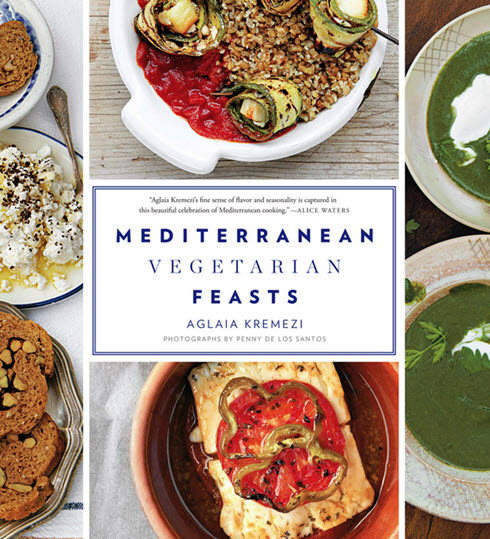
Aglaia Kremezi fairly floats into the room. Wisps of casually arranged auburn hair delicate as ripe corn silk are tempered by a pair of serious wire-rimmed frames that hint at her former life as an editor and journalist. She is utterly composed and cheery all at once. This well-known authority on Greek cuisine has come to the States to promote her newest cookbook, see friends and consult with Michael Costas, Executive Chef at José Andrés’ Greek-inspired restaurant Zaytinya.
After penning five cookbooks on the foods of Greece, Kremezi has of late directed her attention to vegetables, broadening the subject by including the whole of the Mediterranean. Kremezi lives with her husband, Costas Moraitis on the small Greek isle of Kea. For this cookbook she has put together 150 Mediterranean plant-based recipes tested in her kitchens at Kea Artisanal, where she conducts cooking vacations for students from around the world. Many of these historically authentic vegetarian dishes are far more lavish than meat-based dishes.
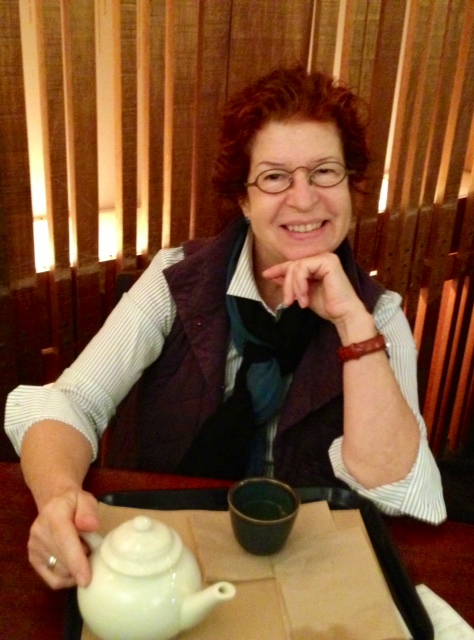 Cookbook Author, Aglaia Kremezi, chats with Whisk and Quill – Photo credit by Jordan Wright Whisk and Quill – What do you think of the current shift to a more vegetable-based diet?
Kremezi – I think that it starts for the wrong reasons, because people think they have to eat healthier, and afterwards they consider the flavors. To me it’s the opposite. I far prefer the flavors of vegetables to the flavors of meat, even though I’m not vegetarian.
How many of your recipes are gleaned from early culinary sources and how many are tweaking through doing?
It’s both really. As you know, because you are a chef too, you take inspiration from this, that and the other and you add your own personal touch. They have my personality but they are taken from various countries from all over the Mediterranean and from friends’ kitchens.
I hear you and Paula Wolfert are great friends and that you Skype regularly. Do you ever cook together?
Oh, yes, in Sonoma and Connecticut. I’m on my way to Sonoma now to spend time with her before I go back to Greece.
The photos in your new book are so vivid, I want to eat the pages.
Penny De Los Santos took the photographs. She’s been to Kea for Saveur and I knew her work. I did take a few of the pictures, but she took all the rest. They are all taken in our house, garden and our outdoor kitchen. In the photos she used the plates given to me from my mother and our tablecloths, cookware and pottery that we have collected over the years.
The photographs are supposed to be the ‘hooks’ to draw people into the kitchen and make them cook, because people have neglected cooking. They rely too much on take out. A lot of companies are very quick to bring vegetarian products to market, but you never really know what’s in them.
Can you tell me some herbs or seasonings that are your favorites?
I like both the Aegean Herb and Hot Pepper Spice Mix, and also the Lebanese Seven-Spice Mixture. That one has cinnamon, cloves, coriander, ginger, allspice, pepper and nutmeg. It’s very aromatic and a bit spicy. It’s the basic spice in Lebanon and they use it in tabbouleh. Both spice recipes are in the book. Also I make my own preserved lemons and there is a recipe for that too in the book.
What are your favorite kitchen tools?
Wooden spatulas and spoons, my mandolin, a very good knife and scissors. I have scissors everywhere! I even use them when I am baking bread to score the tops of the loaves. It works better than a razor.
Your book is going to make readers want to plant their own gardens in order to harvest the many vegetables and herbs you spotlight in your seasonally-inspired recipes. Do you get most of your fresh ingredients from your garden?
Yes, especially herbs. Our seasons are different than yours. Now we are planting lettuces. I just was in Japan and got some kun choi seeds. And we have 10 or 12 kinds of oregano, like the Lebanese zaatar, which is a cross between oregano and thyme. I love farmers markets too. I was at the Dupont Circle Farmers Market on Sunday and today I’m heading over to the market in Penn Quarter to buy apples.
Tell me about your cooking classes on Kea.
It was my husband’s idea. Because we had the garden and we live in the middle of nowhere. We are on the more remote part of the island, the north side. It’s not the side with all the villas like the Hamptons. It is where we can have a garden and it’s less exposed to the harsher weather. Also it was nice to have people from all over the world come and join us every now and then. We love having people around our table.
We have six-day classes. We cook and eat and taste wines and cheeses and honeys from all over Greece. We also do hikes and make travel arrangements for guests who want to explore other islands.
Why do you think this book is so important?
The whole idea started from the interactions I had with the people in our classes. I found that things that I didn’t even think of showing people how to cook – – things I considered self-evident – – like how to braise green beans with tomatoes and onions for example. But they were amazed and they were asking me for the recipes. I realized that people don’t really know how to cook vegetables at all. In the book I have all these variations from country to country around the Mediterranean. For example, I give recipes for two entirely different eggplant spreads, both the Arab and French Provencal versions. Each use roasted eggplant. It’s an example of what I’m trying to do in this book. It’s these variations that really interest me. I do a lot of research and call up my Turkish friends for advice and suggestions.
Kremezi will be in DC at the Sips & Suppers event on January 24th and 25th 2015 along with Alice Waters, Joan Nathan, David Chang, Mike Isabella, Spike Gjerde, Cathal Armstrong, Erik Bruner-Yang, Michael Friedman, Carla Hall, Haidar Karoum, Charles Phan, Jamie Leeds and Peter Jacobson.
Tunisian Chickpea Soup (Leblebi)
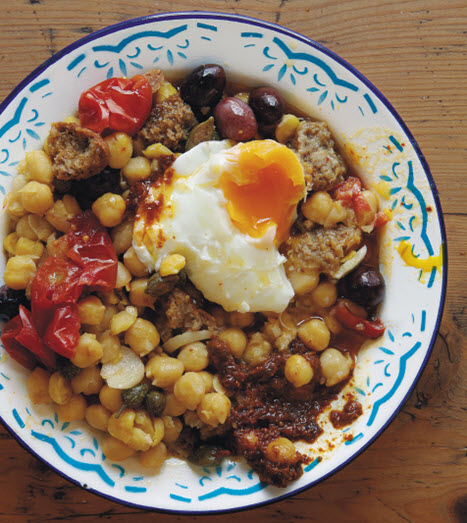
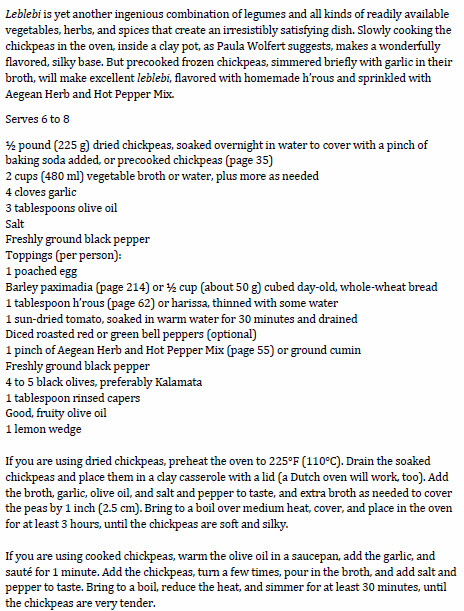
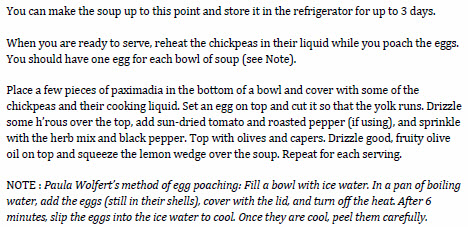
Jordan Wright
November 5, 2014
Local Chef Cathal Armstrong’s Cookbook, My Irish Table – Recipes From the Homeland and Restaurant Eve, Will Warm The Cockles of Your Heart
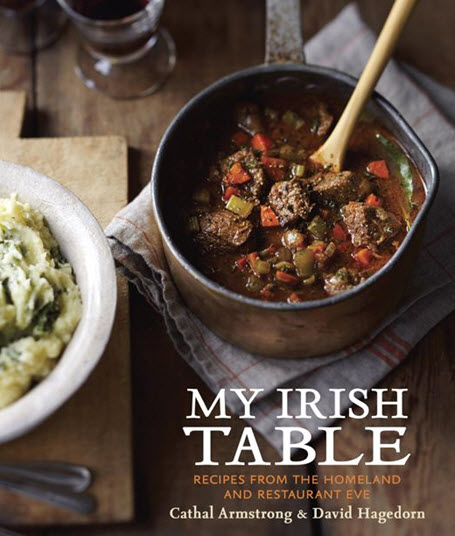
My favorite cookbooks reveal the author’s personal connection to both the recipe and the ingredients, and this one is no different. In Cathal Armstrong’s “My Irish Table – Recipes From the Homeland and Restaurant Eve” (Ten Speed Press, 2014), co-written with former chef and Washington Post food writer David Hagedorn, the hearth-warming book takes us on an Irish culinary journey inspired by Armstrong’s mother’s kitchen and his father’s vegetable garden, and influenced by his early French culinary training.
 Cathal Armstrong As chef/owner of Restaurant Eve, and owner of The Majestic, Eammon’s A Dublin Chipper, PX and Society Fair, all located in Alexandria, Virginia, Armstrong has gotten a heap of ink from some of the world’s leading magazine writers and has twice been chosen from among DC area’s finest chefs to create a year-long Irish-inspired menu for The National Gallery of Art’s Garden Café, so this long-awaited book is a treasure.
At the top of each recipe you’ll find a description of Armstrong’s fondest food memories culled from his childhood in Dublin and dishes from his highly esteemed Restaurant Eve. All the recipes are tailored for the home cook. Here’s one to warm the cockles of your heart on a cold winter’s night.
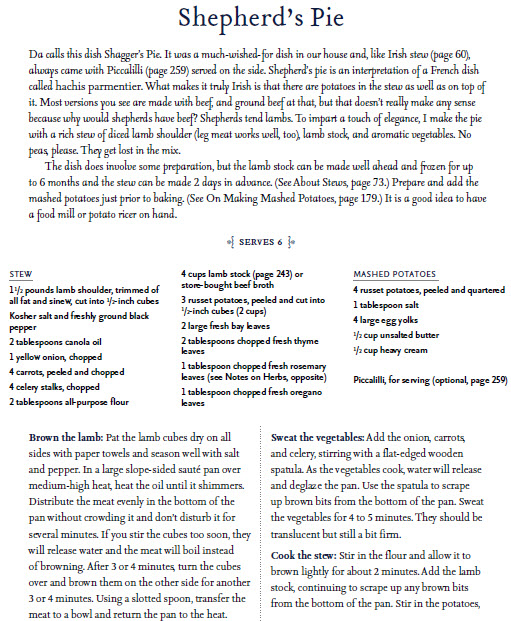

Jordan Wright
August 3, 2014
Special to DC Metro Theater Arts

One of the most beautiful and evocative cookbooks to cross my path of late is the recent issue 7,000 Islands – A Food Portrait of the Philippines by Australian-Filipino food and travel writer Yasmin Newman. A lavishly photographed and comprehensive collection of recipes from around the islands of Southeast Asia, it is especially relevant as we see more and more restaurants opening that feature Asian cuisine. In it Newman takes us to exotic locales to offer up dishes that can be prepared in our own kitchens. Of all the 323 pages of recipes I chose this one, which is a unique way of preparing our Maryland Blue Crabs.
 Ginataang alimasag at buko
Crab and young coconut ginataan Crab and young coconut ginataan One of the most resounding memories I have of the Philippines is of regularly eating crab; the expensive crustacean is a rare treat in Australia. My cousins occasionally enjoy it for breakfast when an affordable batch of live crabs arrives home from the morning market or is received as a gift. The bright orange shells splash colour across the table and we prise the sweet crabmeat from within. Dinner or dinner-party dish, it depends on the price of crab near you. Either way, it’s special. It’s also incredibly quick to prepare. If you prefer, ask your fishmonger to clean the crab for you.
Serves: 4
- 4 raw blue swimmer crabs (about 1 kg / 2 lb 3 oz)
- 80 ml (2 ½ fl oz / 1/3 cup) vegetable oil
- 10 cm (4 inch) piece ginger, peeled and very finely chopped
- 1 small onion, chopped
- 1 small vine-ripened tomato, roughly chopped
- 3 lemongrass stems, white part only, bruised
- 2 long green chiles, halved lengthwise and seeded
- 250 ml (8 ½ fl oz / 1 cup) vegetable stock
- 250 ml (8 ½ fl oz / 1 cup) coconut milk
- 250 ml (9 fl oz / 1 cup) coconut cream
- 2 young cocounts (buko), opened and meat scraped (see method, page 326)
- Steamed rice, to serve
To prepare each crab, lift the triangular tail flap on the underside of the body and gently but firmly pull down to release the top shell. Remove and discard the flap, reserving the top shell. Remove and discard the spongy, finger-like gills, then replace the shell. Cut the body in half. Using a nutcracker or the blunt edge of a large knife, crack the large claws.
Heat the vegetable oil in a large, deep saucepan over medium heat. Add the ginger and cook for 1 minute, stirring until fragrant. Add the onion and cook for 2 minutes, then add the tomato and cook for a further 3 minutes, stirring and pressing until the tomato starts to break down.
Add the lemongrass, chillies, stock and coconut milk to the pan, season with freshley cracked black pepper, then bring to a simmer over medium-high heat. Add the crab, reduce the heat oto medium, and continue to cook for a further 8-10 minutes, turning over the crab pieces halfway – the crab is cooked when the shell changes colour and the meat turns white. Using tongs, remove the crab pieces to a serving bowl.
Add the coconut cream and young coconut meat to the pan, increase the heat to medium-high , and cook for 1-2 minutes, stirring often, until slightly thickened. Remove from the heat, discard the lemongrass and chillies, if desires, and pour over the crab. Serve with steamed rice.
Jordan Wright
May 20, 2014
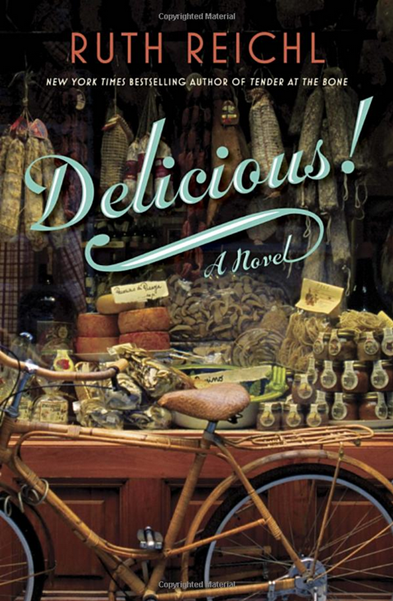
Delicious! A First Novel from Ruth Reichl
When seasoned food writer and four-time James Beard Award-winner Ruth Reichl debuts her first novel (two more are planned), foodies everywhere sit up and take notice. The former restaurant critic, first at the LA Times – – later a six-year stint at the New York Times, is better known for bestselling memoirs like Comfort Me with Apples, Tender at the Bone and Garlic and Sapphires, books that seamlessly blended essays with recipes. In Delicious! (Random House 2014) she proves she can cook up a tale as eloquently as penning a review.
Reichl’s keen insight and food knowledge lend authenticity to a storyabout an aspiring young writer who leaves her family for an entry-level job at a bespoke food magazine that soon after goes belly up. Though she claims her characters evolved on their own, “Over time, all the characters claimed their own territories, refusing to do the things I wanted them to do, taking on their own strong voices”, Reichl’s ten years as Editor-in-Chief of the much beloved, and sorely missed, Gourmet magazine, inform their motivations through every twist and turn. Oh, the parallels!
This light-hearted mystery will intrigue the reader with its ethno-botanical references, intriguing anagrams and culinary clues. Did you know that NYU’s Fales Library had eclipsed Radcliffe’s as America’s largest collection of antique cookbooks? Just one of the little known facts where Reichl reveals her insider’s savvy on epicurean esoterica.
The story is filled with the adventures Billie Breslin and her discovery of a trove of wartime letters between the mysterious Lulu and James Beard. Yes! Reichl has channeled the august James Beard who offers his kindness and wisdom to the budding journalist. Other colorful characters are drawn from Reichl’s vast experience with food emporia and her years in the New York publishing world. When Breslin takes a weekend job at a Greenwich Village cheese shop, you’ll swear you’re on Bleeker Street buying mozzarella di bufala at Murray’s Cheese.
Reichl will be speaking and signing Delicious! at DC’s Politics and Prose on May 29th.
Spring Things
Getting a fresh start on the season once meant foraging for whatever wild edibles popped out of the ground. That means spring sprouters like ramps, violets, redbud flowers, tulip petals (not wild but certainly edible especially when stuffed with herbed goat cheese), mint, the tender shoots of the greenbriar, young dandelion leaves and the lovely morels and chanterelles found in leaf-strewn woods. If you live near a stream, or even a roadside culvert, chances are you’ve already found watercress for your salads and tossing in a few shards of shaved Parmigiano-Reggiano to finish it off.
If you are city-bound and need a jumpstart to your diet, or just want to amp up your workout performance, pick up one of these cookbooks.

Can a Vegan Be a High Performance Athlete?
Canadian Brendan Brazier’s fourth in his series of health-minded books, the Thrive Energy Cookbook (Perseus Books 2014) is perfect for those in high performance training who may be on a plant-based diet or even for those looking for meatless options. As a former Ironman competitor and two-time Canadian Ultra-Marathon Champion, this high-intensity athlete doesn’t sacrifice taste to get the results he wants. As Head of Nutrition for the Garmin-Sharp Pro Cycling Team and creator of Vega, a fantastic award-winning line of whole food nutritional products, he’s expected to please picky athletes. Celeb clients Hugh Jackman, MLB All Star Brian Roberts, and Olympic Gold Medal triathlete Simon Whitfield, follow this regime for optimum performance.
The book has 150 plant-based recipes, a pantry list of must haves, and tons of colorful photos. Okay, what fruit or veggie isn’t colorful? Brazier leaves out yeast, wheat, meat, dairy and refined sugars, but doesn’t neglect desserts, smoothies or power-packed veggie shots. This was one of the hardest books to choose a recipe from, since they are all quite original and delicious. But here’s one that should make your summer a whole lot cooler.
Super-Fruit Sangria from Brendan Brazier’s Thrive Energy Cookbook
Serves 1 – Makes 2 ¼ cups (550 mL) – Gluten Free, Super Nutrient-Dense – Prep Time: 5 minutes – Special Equipment: high-speed blender
- 4 or 5 fresh or frozen strawberries
- 10 fresh or frozen raspberries
- ½ cup (125 mL) fresh or frozen blueberries
- 1/3 cup (75 mL) chopped pineapple
- 2 fresh mint leaves
- Zest of ½ orange
- Zest of ½ lemon
- Zest of ½ lime
- 2 tbsp (30 mL) freshly squeezed orange juice
- 2 tbsp (30 mL) freshly squeezed lemon juice
- 2 tbsp (30 mL) freshly squeezed lime juice
- 2 tbsp (30 mL) pomegranate juice
- 2 tbsp (30 mL) acai berry juice
- 6 tbsp (90 mL) coconut water
- 2 tbsp (30 mL) agave nectar or maple syrup
- 1 tbsp (15 mL) pure vanilla extract
- About 2 cups (500 mL) ice cubes
In a blender, combine all the ingredients except the ice. Add ice to about 1 inch (2.5 cm) above the liquid line. Blend on high speed until smooth and creamy. If using frozen fruit, use less ice.
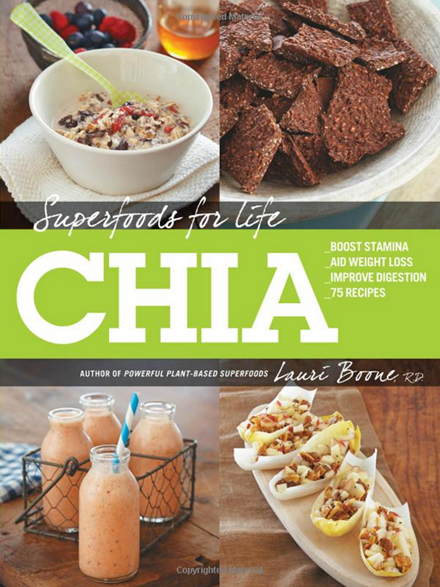
Cha-Cha-Chia: Not Just for Growing Green Hair on Clay Critters
Superfoods for Life, Chia by Lauri Boone (Fair Winds Press 2014) is a 75-recipe book jam-packed with doable ideas for using chia seeds in your daily diet. High in fiber, protein, minerals and essential fatty acids (They’re the good kind!), this tiny seed is cropping up everywhere these days – – in kombucha drinks, crackers, cereal and baked goods. And it’s no wonder. Known as an inflammation fighter and natural source of potent omega-3 fatty acids along with other nutrients, chia seeds can boost stamina, aid in weight loss and improve digestion. Le Pain Quotidian serves it up in puddings and Boone offers a few tasty options for making yours at home including a no-cook one for chocolate lovers.
Boone gets her street cred as a Registered Dietician, raw food instructor and writer for One Green Planet, Self and Oxygen Magazine. She has appeared on CNN, BBC Radio and NPR and blogs regularly about a holistic approach to health and wellness. And we’re all paying more attention to that!
Here’s an easy recipe from Boone’s cookbook.
Lemon, Coconut & Chocolate Chia Bark
This is an incredibly simple and decadent sweet treat combining smooth and creamy dark chocolate with crunchy chia seeds, dried coconut, and lemon zest. I like to use dark chocolate chips, which have a higher percentage of heart-healthy cacao than other varieties, but feel free to use your favorite chip, including nondairy chocolate chips or carob chips.
- 1 bag (9 ounces, or 255 g) dark chocolate chips
- 1⁄2 cup (43 g) shredded dried coconut
- 1⁄4 cup (50 g) chia seeds
- 1 tablespoon (6 g) lemon zest
- Pinch of sea salt
- Melt the chocolate chips in a small saucepan over medium heat, stirring occasionally, until smooth and creamy.
- Remove from the heat and stir in the dried coconut, chia seeds, and lemon zest.
- Spread the thick mixture into an even layer on a baking sheet lined with waxed paper. Freeze until hard, about 30 minutes.
- Break into bite-size chunks. Store in an airtight container.
- Yield: About 24 pieces
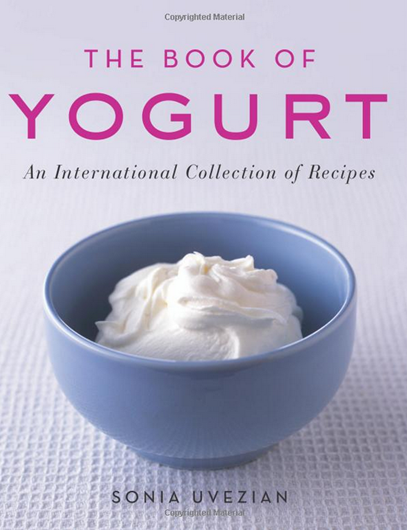
Probiotics Rule
It may seem that an entire book on yogurt may be overkill. But I assure you it is not. Sonia Uvezian knowledge of the tasty dairy product originates with her upbringing in Armenia and Lebanon, both of which incorporate yogurt in their daily diet.
In The Book of Yogurt – An International Collection of Recipes (HarperCollins) she has compiled both old and new recipes using yogurt. I especially like her Chilled Cherry Soup for summer and Ghivetch, a Rumanian veggie casserole that uses 12 vegetables plus grapes and greengage plums. Though the book has been out for a while, I thought it would add to the health-consciousness of this scribble.
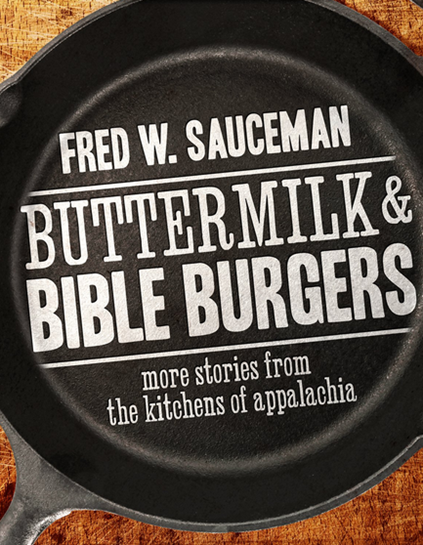
Off the Beaten Track with Fred Sauceman
Fred Sauceman’s Buttermilk and Bible Burgers: More Stories from the Kitchens of Appalachia (Mercer University Press 2014) is the latest for author, NPR radio broadcaster and college professor whose celebration of the American South is legendary. I’ve already seen most of his documentaries, “Red Hot Dog Digest”, “Mountain Mojo: A Cuban Pig Roast in East Tennessee”, “Beans All the Way: A Story of Pintos and Persistence”, “Smoke in the Holler: The Saucy Story of Ridgewood Barbecue” and “Ramps & Ruritans: Tales of the Revered and Reeking Leek of Flag Pond, Tennessee”. The titles say it all.
The 57-year-old’s love for the rural, most especially the backwoods and backstory of Appalachian foodways, is infectious – like riding down a dusty road in the cab of an old pickup listening to a country boy spin stories. Just hearing him honor the food culture and traditions of South is as satisfying as seeing a curl of smoke rise up off a rack of ribs at a roadhouse.
A native of Greenville, Tennessee, Sauceman is Senior Writer and Associate professor of Appalachian Studies at East Tennessee State University. He’s also known for his radio appearances on “Inside Appalachia”, a radio program produced on West Virginia Public Broadcasting, daily newscasts on WETS-FM/HD and “Food With Fred” which appears monthly on WJHL-TV, the CBS affiliate in Johnson City, TN. He is also a regular contributor to the Southern Food and Beverage Museum of New Orleans where he writes for the museum’s magazine Okra. His three-volume book series entitled “The Place Setting” Timeless Tastes of the Mountain South, From Bright Hope to Frog Level”, was also published by Mercer Press.
Recently I interviewed Sauceman by phone in anticipation of the release of his latest book.
Whisk and Quill – How many years have you been teaching and chronicling the food ways of Tennessee, Virginia, North Carolina and Kentucky?
Fred Sauceman – I’ve been writing about food-related topics since the mid-1990s and taught American Literature courses in the past. In 2005 I began offering a first-of-its-kind course entitled “The Foodways of Appalachia”, which has become the most popular course in Appalachian Studies at ETSU.
W&Q – What are your other writing outlets?
Sauceman – There are a number of publications I write for, among them the Johnson City Press where I have a monthly food column, “Potluck”, as well as the “Flavors” page for Blue Ridge Country Magazine.
W&Q – What is your connection to the Southern Foodways Alliance?
Sauceman – In 2010 edited the organization’s book “Cornbread Nation 5: The Best of Southern Food Writing”, and created the book Home and Away: A University Brings Food to the Table” in 2000. In 2010 I was one of the authors of “The Southern Foodways Alliance Community Cookbook”.
W&Q – How many years have you been in radio?
Sauceman – I started in radio when I was 15 with a rock and roll program on Saturday and Sunday nights. Later I became a country music DJ while working on my degrees. I also worked in television news with the ABC affiliate in Kingsport, TN.
W&Q – How can people order your DVDs?
Sauceman – Through the university at www.ETSUstore.com.
W&Q – What’s your favorite BBQ joint?
Sauceman – The Ridgewood Barbecue in Bluff City, Tennessee.

Easy Peasy Cooking for Diabetics
Robyn Webb’s The Smart Shopper Diabetes Cookbook offers real time strategies for making stress-free meals. Designed with the harried home chef in mind, the book sources ingredients from the deli counter, freezer, salad bar and supermarket shelves to put a healthy meal on the table in no time flat. It comes with the stamp of approval from the American Diabetes Association.
As an author, nutritionist and Food Editor of Diabetes Forecast, Robyn already has fifteen cookbooks under her belt and is a two-time award winning author of The Diabetes Comfort Food Cookbook. She has also appeared on Martha Stewart Radio, Food Network, Discovery Channel, CNN, ABC, CBS, ESPN and more, and as a local food writer her work has been highlighted in the Washington Post along with a ton of national magazines.
A resident of the DC Metro area, she conducts cooking classes, speaks to groups on nutrition, and even caters special events keeping in mind those with diabetes, pre-diabetes and heart conditions.
Here’s a recipe for the perfect cold summer side dish. Or serve it hot with melted goat cheese on top. I might try it as a main course with a fresh green salad and a bowl of Robyn’s Ginger Honeydew Soup to start.
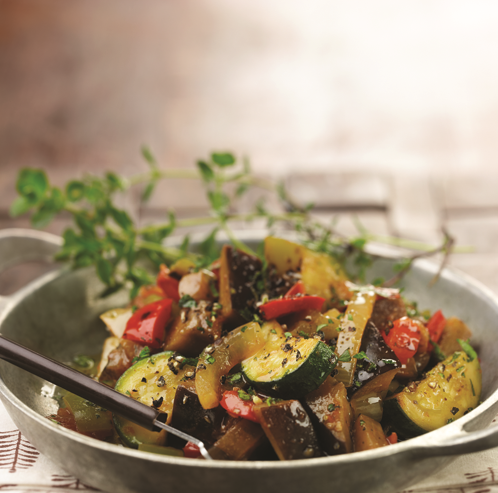 Ratatouille recipe 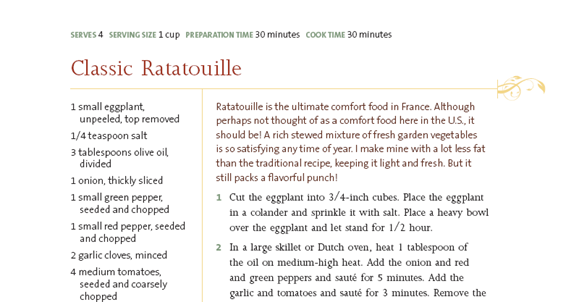 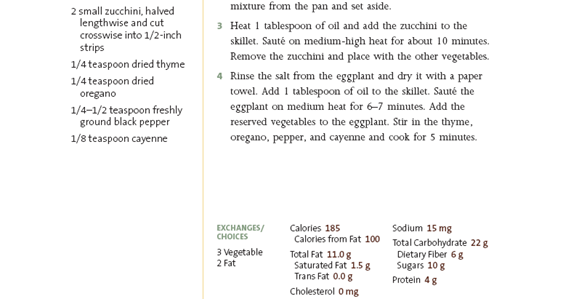
The writing team of Bob Drury and Tom Clavin are best known to their readers as American military historians. Noted for turning out impeccably researched chronicles, their books range in coverage from World War II and Korea to the Vietnam War and usually grace The New York Times bestseller list. But for all their military acumen, the two had overlooked one of the biggest stories in American history: That of Chief Red Cloud, who led the Western Sioux Nation to victory against the U.S.The Heart of Everything That Is: The Untold Story of Red Cloud, an American Legend (Simon & Schuster, November 2013) was born.
Before that, Drury and Clavin had been kicking around a few ideas for their next subject when they found themselves at the Marine Corps Base at Quantico as they accepted an award for Best Nonfiction from the Marine Corps Heritage Foundation.
“After the ceremony a Marine said to us, ‘You do know about the only Indian to win a war against the United States?’ ” Drury told Indian Country Today Media Network. “We said we were familiar with the Battle of Big Horn and other well-known battles. And then he said, ‘I didn’t say battle, I said war! An entire war.’ And I thought, Why didn’t we know about that?”
The Marine then told them about Red Cloud, chief of the Western Sioux Nation. The two were stunned to discover that the warrior in question was not Geronimo, Sitting Bull or Crazy Horse—proud fighters who most schoolchildren are taught about. They knew then that they had their next book.The Heart of Everything That Is tells Red Cloud’s story in his own words (he related his tale to a third party before he died) and lays out a riveting timeline of the period.
In researching his life, the authors uncovered a wealth of material from diaries and letters written by U. S. military officers and their wives and children, and wilderness trackers, plus a treasure trove of historical information gleaned from the letters and journals of the pioneers who crossed the Great Plains during the 1800s. Indian Country Today Media Network caught up with each author recently to gain insight into what compelled them to learn more about Red Cloud and write, “His overall leadership, his organizing genius, and his ability to persuade contentious tribes to band together…had enabled perhaps the most impressive campaign in the annals of Indian warfare.”
Your book is meticulously researched, full of the smallest details of life on the American Plains. What surprised you most in your studies of that period?
Clavin: The biggest surprise was how little we know of Red Cloud in our popular culture. We know a great deal about Geronimo, Cochise, Sitting Bull and Crazy Horse. But Red Cloud wasn’t discussed at all in our history books. As we did more research we discovered stories of his exploits and of his importance in Sioux society and their culture and history.
It was shocking to us that he was little more than a footnote to what we know about the American West. It’s been mostly the white academics and white scholars who have written about the Indian. The Indian point of view has been mostly through the observation of others, as with Frances Parkman’s The Oregon Trail.
What drew you to the story of Red Cloud?
Clavin: I was reading a description of the Fetterman massacre and Red Cloud and thought I was pretty well versed in eighteenth-century history. But ultimately when we decided to take on the story of Red Cloud, it became a four-year journey.
Drury: We saw his life was rich during the period of Manifest Destiny. It told of a way of life that had gone on for a millennium. We were accustomed to interviewing living people. But what we found was almost like Twitter, everyone kept a journal back then. Tom went to all the historical societies and university libraries out west and found so many letters. Some of the documents were so fragile that we had to handle them with gloves. Reading these journals was like interviewing living people. It was an amazing discovery. For example, no one knew how the Indians ‘treatied’ with each other.
Would the Plains Indians have survived without the trading posts and contact with whites?
Clavin: They probably would have survived much better! The trading posts were very destructive to them. They seduced the Indians from finding their own food and clothing, which they had always done. It also introduced alcohol to them and brought diseases they had no immunity from, like smallpox and cholera.
What was Red Cloud’s legacy to the Sioux?
Clavin: Once he retired as a military leader and after he could see the growing military power of the white people, he wanted to be sure that the Lakota Sioux and their children had education and medical care. He was an advocate in Washington for funds and other resources to come back to the reservation.
What does the book’s title mean?
Clavin: The Lakota Sioux name for the Black Hills ispaha sapa. The area straddles the border between Wyoming and Southwestern South Dakota. They considered it their sacred territory—where they came from. The translation is “the heart of everything that is.”
Does Red Cloud have descendants?
Clavin: Tribal leaders have been descendants of Red Cloud, the leader of the Oglala Sioux, who was considered their leader until he died in 1909. Then it was Jack, his son, then James, his son, then Oliver Red Cloud, his son who died this past July at 93. His son, Lyman, was supposed to take over as leader, but died two weeks later. I have heard there is now a vacuum in terms of their spiritual figurehead.
Do they still live on the Pine Ridge reservation?
Clavin: Quite a few still do. Though some also attend school outside of the reservation and marry outside, there are still grandchildren and great-great- grandchildren living there.
What surprised you the most in your research?
Drury: Well, there were so many things that surprised me. For example, we have the Alamo, the Battle of Big Horn and the Fetterman fight, which somehow had gotten lost in the mists of time. The story is about the demise of one nation, Red Cloud’s nation, and the rise of another nation, the continental power of the United States—and in the middle of it was the Fetterman fight.
Another was old Jim Bridger, the self-taught trapper and explorer. Why were Daniel Boone, Davy Crockett, Kitt Carson and all these iconic figures mentioned in our American history books but not Bridger? I think he is the most fascinating character in the book because his story lends so much to the book’s narrative. He and Red Cloud lived almost parallel lives on this vast continent. During this period mapmakers described the vast interior of the country as the great American desert. But during their lifetimes we annexed Texas, fixed the Canadian boundary, defeated Santa Ana and took over many of the western and northwestern states. All of a sudden we were becoming a nation, and at the same time Red Cloud was in charge of what whites considered a nation. So it was inevitable that these two nations were going to clash. And this was witnessed by Jim Bridger and Crazy Horse, among others of the period. I wonder to this day why he is not up there in the pantheon of Western pioneers.
What is your takeaway?
Drury: If we had just honored that final treaty, because Red Cloud’s war never really ended, even though he signed a treaty. It still continues in the courts today, because we broke so many treaties. But if we had just honored that final treaty that ended Red Cloud’s war, this would be a better country today for everyone.
So why did two white guys think they could write about the history of American Indians?
Drury: My only answer is I didn’t serve in World War II, but that didn’t stop me from writing Halsey’s Typhoon and doing a good job of it. I didn’t serve in the Korean War but that didn’t stop me from writing The Last Stand of Fox Company, and I was even too young for Vietnam, but that didn’t stop us from writing Last Men Out. So in the same sense I don’t think color, age or creed matters when you’ve got a ripping good yarn. And this one’s a great saga with epic sweep.
Read more at
http://indiancountrytodaymedianetwork.com/2014/03/16/heart-everything-chief-red-clouds-untold-story-revealed-154026?page=0%2C2
|

























